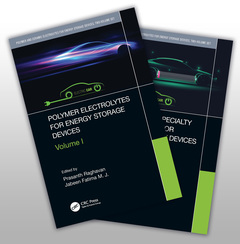Polymer and Ceramic Electrolytes for Energy Storage Devices, Two-Volume Set
Coordonnateurs : Raghavan Prasanth, Fatima Jabeen

Polymer and Ceramic Electrolytes for Energy Storage Devices features two volumes that focus on the most recent technological and scientific accomplishments in polymer, ceramic, and specialty electrolytes and their applications in lithium-ion batteries. These volumes cover the fundamentals in a logical and clear manner for students, as well as researchers from different disciplines, to follow.
The set includes the following volumes:
?
- Polymer Electrolytes for Energy Storage Devices offers a detailed explanation of recent progress and challenges in polymer electrolyte research for energy storage devices.
?
- Ceramic and Specialty Electrolytes for Energy Storage Devices investigates recent progress and challenges in a wide range of ceramic solid and quasi-solid electrolytes and specialty electrolytes for energy storage devices.
These volumes will be of high value to researchers and engineers working on the development of next-generation energy storage devices, including materials and chemical engineers, as well as those involved in related disciplines.
?
Volume 1.
Chapter 1.Electrochemical Energy Storage Systems: The state-of-the-art Energy Technologies
Chapter 2.The Great Nobel Prize History of Lithium Ion Batteries: The New Era of Electrochemical Energy Storage Solutions
Chapter 3.Polyethylene Oxide (PEO) co-polymer based Solid Polymer Electrolytes for Rechargeable Lithium Ion Batteries
Chapter 4.Polymer Nanocomposites based Solid State Electrolytes for Lithium Ion Batteries
Chapter 5.Poly(vinylidene fluoride) (PVdF) based Polymer Electrolytes for Lithium Ion Batteries
Chapter 6.Poly(vinylidene fluoride-co-hexafluoropropylene) (PVdF-co-HFP) based Gel Polymer Electrolyte for Lithium Ion Batteries
Chapter 7.Polyacrylonitrile (PAN) based Polymer Electrolyte for Lithium Ion Batteries
Chapter 8.Polymer Blend Electrolytes for High Performance Lithium Ion Batteries
Chapter 9.Polymer Clay Nanocomposite Electrolyte for Lithium Ion Batteries
Chapter 10.Polymer Silica Nanocomposite Gel Electrolytes for Lithium Ion Batteries
Chapter 11.Polymer-ionic Liquid Gel Electrolyte for Lithium-Ion Batteries
Chapter 12.Biopolymer Electrolytes for Energy Storage Applications
Volume 2
Chapter 1.Solid State Electrolytes for Lithium Ion Batteries: Performance Requirements and Ion Transportation Mechanism in Solid Polymer Electrolytes
Chapter 2.Solid State Electrolytes for Lithium Ion Batteries: Novel Lithium Ion Conducting Ceramic Materials: Oxides (Perovskite, Anti-Perovskite) and Sulfide Type Ion Conductors
Chapter 3.Solid State Electrolytes for Lithium Ion Batteries: Novel Lithium Ion Conducting Ceramic Materials: NASICON and Garnet type Ionic Conductors
Chapter 4.Polymer and Ceramic based Quasi Solid Electrolytes for High Temperature Rechargeable Energy Storage Devices
Chapter 5.Quasi Solid State Electrolytes for Lithium-Ion Batteries
Chapter 6.Electrolytes for High Temperature Lithium Ion Batteries: Electric Vehicles and Heavy Duty Applications
Chapter 7.Electrolytes for Low Temperature Lithium Ion Batteries Operating in Freeze Cold Weather
Chapter 8.Electrolytes for Magnesium Ion Batteries-the Next Generation Energy Storage Solution for Powering the Electric Vehicles
Chapter 9.Aqueous Electrolytes for Lithium and Sodium Ion Batteries
Chapter 10.Transparent Electrolytes: a Promising Pathway for Transparent Energy Storage Devices in Next Generation Optoelectronics
Chapter 11.Recent advances in non-platinum based cathode electrocatalysts for direct methanol fuel cells
Chapter 12.Platinum (Pt) free anode electrocatalysts for methanol oxidation in direct methanol fuel cells
Chapter 13.Ionic Liquid based Electrolytes for Supercapacitor Applications
Dr. Prasanth Raghavn is a professor in the Department of Polymer Science and Rubber Technology at Cochin University of Science and Technology (CUSAT). He received his PhD in Engineering from the Geyongsang National University in 2009, under the prestigious Brain Korea (BK21) Fellowship. He completed his B.Tech and M.Tech from CUSAT, India. After serving a few years as Project Scientist at the Indian Institute of Technology (IIT-D), New Delhi, he moved abroad for his PhD studies in 2007. His PhD research was focused on the fabrication and investigation of nanoscale fibrous electrolytes for high performance energy storage devices. He completed his Engineering doctoral degree in less than three years, an unbroken record in the Republic of Korea. After obtaining his PhD, Dr. Prasanth joined as a research scientist at Nanyang Technological University (NTU), Singapore, in collaboration with the Energy Research Institute at NTU (ERI@N) and TUM CREATE, a joint electromobility research centre between Germany's Technische Universität München (TUM) and NTU. After 4 years in Singapore, Dr. Prasanth moved to Rice University as a research scientist, where he worked with Prof. Pulickal M Ajayan, the co-inventor of Carbon Nanotubes. Dr. Prasanth was selected for the Brain Korea Fellowship (2007), SAGE Research Foundation Fellowship, Brazil (2009), Estonian Science Foundation Fellowship, European Science Foundation Fellowship (2010), Faculty Recharge, and UGC (2015). He received several international awards including the Young Scientist award from the Korean Electrochemical Society (2009) and the Bharat Vikas Yuva Ratna Award (2016). He developed many products such as high performance breaking parachutes, flex wheels for space shuttles, high performance lithium ion batteries for leading portable electronic devices and automobile industries. He has a general research interest in polymer synthesis and processing, nanomaterials, green/nanocomposites, and electrospi
Date de parution : 03-2021
15.6x23.4 cm
Disponible chez l'éditeur (délai d'approvisionnement : 12 jours).
Prix indicatif 264,06 €
Ajouter au panier


